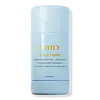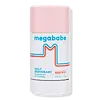What's inside
What's inside
 Key Ingredients
Key Ingredients

 Benefits
Benefits

 Concerns
Concerns

 Ingredients Side-by-side
Ingredients Side-by-side

Caprylic/Capric Triglyceride
MaskingCocos Nucifera Oil
MaskingTapioca Starch
Stearyl Alcohol
EmollientMagnesium Hydroxide
AbsorbentParfum
MaskingHydrogenated Castor Oil
EmollientOryza Sativa Bran Wax
Skin ConditioningBehenyl Alcohol
EmollientPolyglyceryl-3 Stearate
EmulsifyingMandelic Acid
AntimicrobialXylityl Sesquicaprylate
AntimicrobialAnhydroxylitol
HumectantMangifera Indica Seed Butter
Skin ConditioningPlatonia Insignis Seed Butter
EmollientTocopherol
AntioxidantCaprylic/Capric Triglyceride, Cocos Nucifera Oil, Tapioca Starch, Stearyl Alcohol, Magnesium Hydroxide, Parfum, Hydrogenated Castor Oil, Oryza Sativa Bran Wax, Behenyl Alcohol, Polyglyceryl-3 Stearate, Mandelic Acid, Xylityl Sesquicaprylate, Anhydroxylitol, Mangifera Indica Seed Butter, Platonia Insignis Seed Butter, Tocopherol
Propylene Glycol
HumectantWater
Skin ConditioningSodium Stearate
CleansingSaccharomyces Ferment
Skin ConditioningPropanediol
SolventZea Mays Starch
AbsorbentParfum
MaskingHydrated Silica
AbrasiveRosa Damascena Flower Oil
MaskingSqualane
EmollientSalix Alba Bark Extract
AstringentCaffeine
Skin ConditioningArginine
MaskingAvena Sativa Kernel Flour
AbrasiveGlycerin
HumectantCamellia Sinensis Leaf Extract
AntimicrobialAloe Barbadensis Leaf Juice
Skin ConditioningSalvia Officinalis Leaf Extract
CleansingLeuconostoc/Radish Root Ferment Filtrate
AntimicrobialCocos Nucifera Oil
MaskingSilica Cetyl Silylate
Ethylhexylglycerin
Skin ConditioningHydrogenated Olive Oil Unsaponifiables
EmollientPhenoxyethanol
PreservativeSodium Benzoate
MaskingPotassium Sorbate
PreservativePropylene Glycol, Water, Sodium Stearate, Saccharomyces Ferment, Propanediol, Zea Mays Starch, Parfum, Hydrated Silica, Rosa Damascena Flower Oil, Squalane, Salix Alba Bark Extract, Caffeine, Arginine, Avena Sativa Kernel Flour, Glycerin, Camellia Sinensis Leaf Extract, Aloe Barbadensis Leaf Juice, Salvia Officinalis Leaf Extract, Leuconostoc/Radish Root Ferment Filtrate, Cocos Nucifera Oil, Silica Cetyl Silylate, Ethylhexylglycerin, Hydrogenated Olive Oil Unsaponifiables, Phenoxyethanol, Sodium Benzoate, Potassium Sorbate
 Reviews
Reviews

Ingredients Explained
These ingredients are found in both products.
Ingredients higher up in an ingredient list are typically present in a larger amount.
Cocos Nucifera Oil is obtained from the kernels of the coconut fruit. In other words, this is coconut oil.
Coconut Oil is rich in fatty acids with lauric acid making up the majority of these. It also contains linoleic acid. Due to this high fatty acid content, coconut oil helps trap moisture and soften skin.
Despite being antibacterial, coconut oil may not be great for acne-prone skin. It is comedogenic and may clog pores. This ingredient may not be safe for malassezia or fungal acne.
Note: Coconut Oil should not replace your sunscreen for UV protection. Studies show it only blocks about 20% of UV.
This oil is non-volatile and has a light scent.
The term 'fragrance' is not regulated in many countries. In many cases, it is up to the brand to define this term. For instance, many brands choose to label themselves as "fragrance-free" because they are not using synthetic fragrances. However, their products may still contain ingredients such as essential oils that are considered a fragrance.
Learn more about Cocos Nucifera OilParfum is a catch-all term for an ingredient or more that is used to give a scent to products.
Also called "fragrance", this ingredient can be a blend of hundreds of chemicals or plant oils. This means every product with "fragrance" or "parfum" in the ingredients list is a different mixture.
For instance, Habanolide is a proprietary trade name for a specific aroma chemical. When used as a fragrance ingredient in cosmetics, most aroma chemicals fall under the broad labeling category of “FRAGRANCE” or “PARFUM” according to EU and US regulations.
The term 'parfum' or 'fragrance' is not regulated in many countries. In many cases, it is up to the brand to define this term.
For instance, many brands choose to label themselves as "fragrance-free" because they are not using synthetic fragrances. However, their products may still contain ingredients such as essential oils that are considered a fragrance by INCI standards.
One example is Calendula flower extract. Calendula is an essential oil that still imparts a scent or 'fragrance'.
Depending on the blend, the ingredients in the mixture can cause allergies and sensitivities on the skin. Some ingredients that are known EU allergens include linalool and citronellol.
Parfum can also be used to mask or cover an unpleasant scent.
The bottom line is: not all fragrances/parfum/ingredients are created equally. If you are worried about fragrances, we recommend taking a closer look at an ingredient. And of course, we always recommend speaking with a professional.
Learn more about Parfum